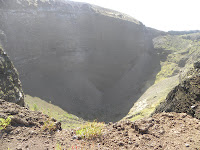





(Pictures: View of Naples from the top of Mt. Vesuvius, view of Pompeii, Mt. Vesuvius in clouds, the path leading to the top, the crater at the peak, the volcanic walkway along the top.)
Quel che non ammazza, ingrassa.
(What won't kill you, will feed you.)
Nook of Naples: Mt. Vesuvius looms over every vantage point in Naples and the surrounding areas. The only active volcano on the continent of Europe, Vesuvius is over twelve thousand years old. Its highest point is 1270 meters high. Records show that before 79 AD (the year of the eruption that covered Pompeii), its slopes were probably covered by forest and at its foot the lush soil made cultivation of various crops easy, especially vineyards.
A visit up its slopes means driving up a narrow winding road, easily following the signs, until the parking lot to the national park. The walk up to the peak takes about 20 minutes, souvenir shops and cafes available along the way. The breathtaking view of Naples along with the three islands of Capri, Ischia, and Procida make the steep climb pleasureable.
Once at the top, I look down into a steep crater, its rock formations impressive, but I'm a little disappointed because I expected to see bubbling lava. Instead, it's all dry rock. But the trek along the volcano still feels a bit daring. Vulcanologists anticipate another eruption sometime soon. Interestingly, that doesn't prevent Neapolitans from building a sprawling metropolitan area right at the foot of the volcano.
Book: In the Shadow of Vesuvius: A Cultural History of Naples by Jordan Lancaster is a smooth read that gives a fun history of the city.
La Cuinca Napoletana: To plant a seed in this region means that it will sprout and grow within minutes. At least, that's how it seems. Part of the reason is that the soil around the Mt. Vesuvius area is extremely fertile. Fruits and vegetables abound and restaurant menus are filled with non-meat dishes that are extremely tasty.
The eggplant is the vegetable I see most. Eggplant can be served marinated in olive oil, grilled and seasoned with parsley or basil, fried and tossed in pasta, simmered within a tomato and basil ragu sauce, and more. The most renown eggplant dish is, of course, Eggplant Parmesan and yep -- the first mention of the dish was in Vincenzo Corrado's 1765 Il cuoco galante (The Gallant Cook), which was also the first Neapolitan cookbook. This classic version is never breaded before frying, the sauce and cheeses are sparing, and the dish is often eaten on the side.
Parmigiana Di Melanzane
3 pounds eggplant
4 cups tomato sauce
1-1 1/2 cups of extra-virgin olive oil
1 cup diced mozzarella
1 cup basil leaves
1 1/2 cups grated Parmesan cheese
Wash and dry the eggplant. In a skillet, heat about 1/3 inch of oil and fry a few slices of eggplant at a time. Spread about 3/4 cup of tomato sauce over the bottom of a baking dish and place a layer of eggplant on the sauce, then a layer of mozzarella, another 1/2 cup of sauce, 1/3 cup of the basil leaves and 1/2 cup grated Parmesan cheese. Repeat with a second layer of eggplant along with the other ingredients, then a third layer. Top the dish with the remaining ingredients. Preheat over to 350 degrees. Bake for 30 minutes or until bubbly. It can be served at room temperature or warm.
(This recipe is a paraphrased version from Naples At Table by Arthur Schwartz.)
3 comments:
Awesome pictures, this is great site to find out the interesting places in Naples
Love the site
Post a Comment